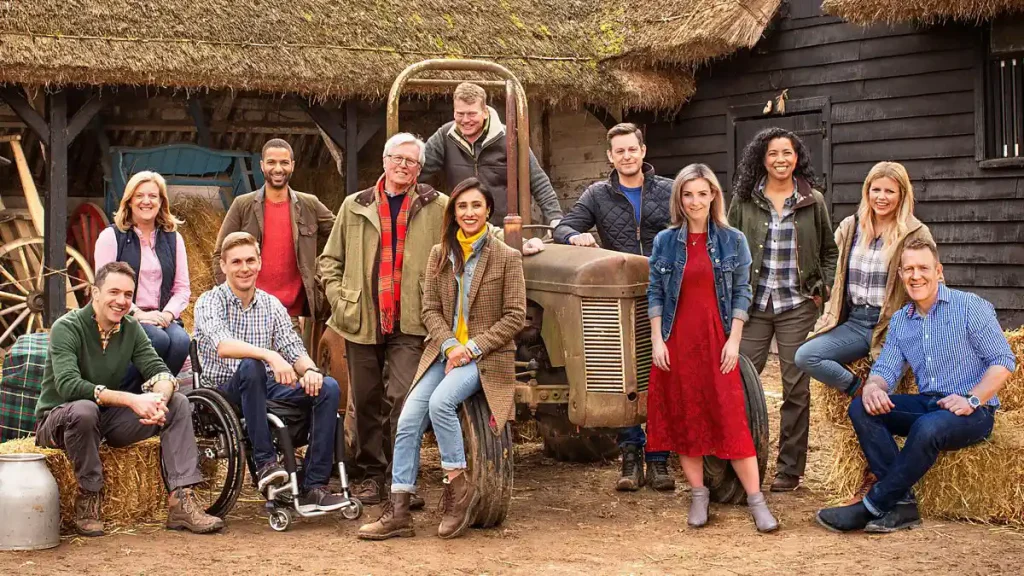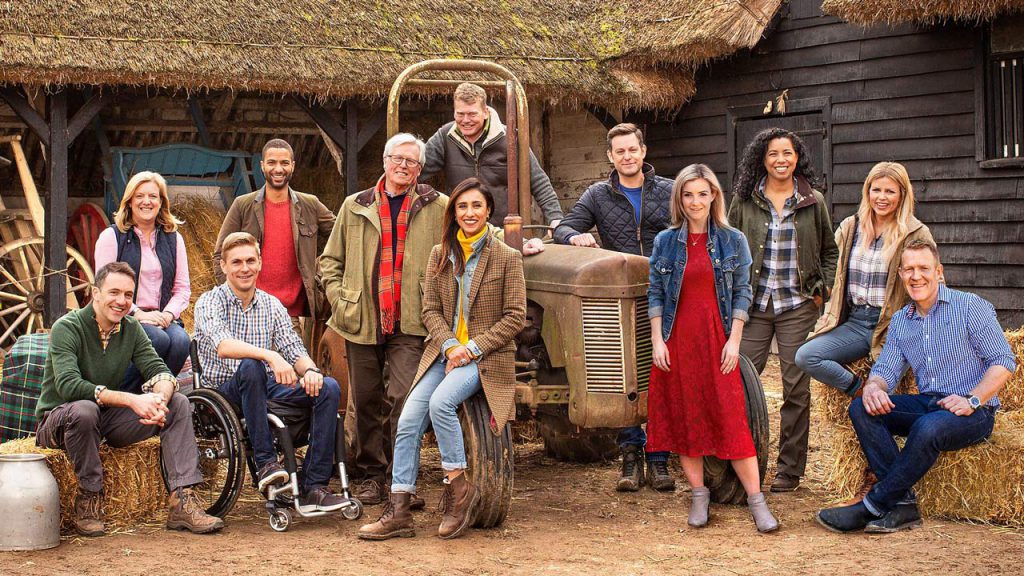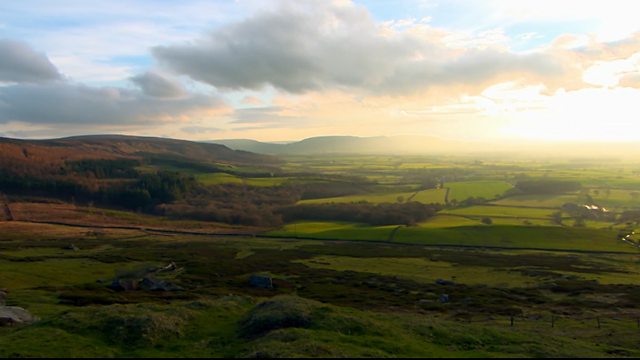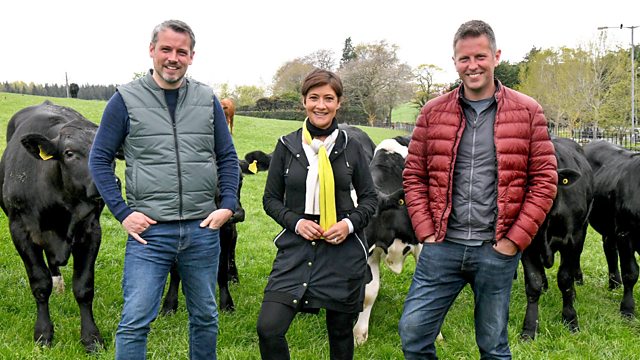Countryfile – Bannau Brycheiniog – In the picturesque Usk Valley, nestled within Bannau Brycheiniog, Sean Fletcher and Matt Baker journey into what many still remember as the Brecon Beacons. Bannau Brycheiniog isn’t just a name; it’s a symbol of evolution. This moniker stands as a testament to the broader shifts taking place within the national park’s very management. As they traverse this beautiful landscape, Sean and Matt dive deep into an array of innovative projects and pioneering initiatives that have taken root. Each of these endeavors has a unified goal: to rejuvenate nature, harmonize the interests of its residents, workers, and visitors, and pave the path for a more sustainable and green future for Bannau Brycheiniog.
Yet, as with any change, not all have embraced this new direction with open arms. Venturing deeper, Sean takes the opportunity to engage with local businesses, seeking to understand their perspectives and reactions to these transformations. Along the way, he stumbles upon an audacious blueprint – an aspiration to sustain the park’s 33,000 residents solely on food cultivated within its boundaries.
Meanwhile, Matt embarks on a different mission, ascending into the hills to confront a particularly troublesome plant species. In doing so, he delves into a restoration project that aims to revitalize a landscape that has, over time, become devoid of its natural vibrancy.
Amidst these narratives, Charlotte Smith delves into a pressing question: In our pursuit to reserve lands in the name of conservation, are we inadvertently placing livestock farms at risk? And on a lighter note, Adam Henson is thrilled to present the inaugural contestants of this year’s ‘One Man and His Dog’ competition. The adventures, challenges, and stories of these passionate individuals paint a vivid picture of a region in transition, brimming with hope and ambition for the future.
Countryfile – Bannau Brycheiniog – A Landscape in Transition
In the picturesque Usk Valley, nestled within Bannau Brycheiniog, Sean Fletcher and Matt Baker journey into what many still remember as the Brecon Beacons. Bannau Brycheiniog isn’t just a name; it’s a symbol of evolution. This moniker stands as a testament to the broader shifts taking place within the national park’s very management. As they traverse this beautiful landscape, Sean and Matt dive deep into an array of innovative projects and pioneering initiatives that have taken root. Each of these endeavors has a unified goal: to rejuvenate nature, harmonize the interests of its residents, workers, and visitors, and pave the path for a more sustainable and green future for Bannau Brycheiniog.
Yet, as with any change, not all have embraced this new direction with open arms. Venturing deeper, Sean takes the opportunity to engage with local businesses, seeking to understand their perspectives and reactions to these transformations. Along the way, he stumbles upon an audacious blueprint – an aspiration to sustain the park’s 33,000 residents solely on food cultivated within its boundaries.
Meanwhile, Matt embarks on a different mission, ascending into the hills to confront a particularly troublesome plant species. In doing so, he delves into a restoration project that aims to revitalize a landscape that has, over time, become devoid of its natural vibrancy.
Amidst these narratives, Charlotte Smith delves into a pressing question: In our pursuit to reserve lands in the name of conservation, are we inadvertently placing livestock farms at risk? And on a lighter note, Adam Henson is thrilled to present the inaugural contestants of this year’s ‘One Man and His Dog’ competition. The adventures, challenges, and stories of these passionate individuals paint a vivid picture of a region in transition, brimming with hope and ambition for the future.
The Meaning Behind the Name
Bannau Brycheiniog is the Welsh name for what was previously known as the Brecon Beacons National Park. Translated literally, it means “the Brecon Beacons mountain range”. The name change in 2012 reflects a broader shift in how the park is managed and perceived.
Brecon Beacons evoked images of iconic mountain peaks and rugged landscapes. But Bannau Brycheiniog encompasses so much more – the valleys, villages, rivers, moorlands, and communities within the park’s boundaries. Adopting this name was an important statement – signaling a renewed focus on sustaining the local culture, people, and economy in balance with conserving the natural environment.
Pioneering Projects Taking Root
Bannau Brycheiniog has become a hub of innovation, with various projects pioneering more sustainable ways to manage the land. Sean Fletcher meets with park representatives to learn about their ambitious vision for the future.
One initiative aims to eventually supply all food for the park’s 33,000 residents from within its boundaries. Local farmers are transitioning to regenerative agriculture – focusing on soil health, biodiversity, and carbon sequestration. Community gardens, urban farms, and homesteading are also growing, enabled by planning policy changes. It’s a bold aspiration, highlighting the shifts in mindset taking place.
Elsewhere, sustainable building projects are popping up using local timber. Sean visits a carbon-neutral visitor center which blurs the lines between outdoor and indoor spaces. Its green roof and rammed earth walls act as natural insulation. Inside, renewable energy keeps costs down.
Initiatives like these align environmental stewardship with economic prosperity and community wellbeing. As Sean discovers, Bannau Brycheiniog aims to be a global leader in sustainability.
Restoring Natural Vibrancy
While Bannau Brycheiniog progresses on many fronts, some landscapes remain degraded from past land use. Matt Baker joins an ecological restoration team tackling invasive rhododendron threatening native flora.
Rhododendron forms dense thickets, blocking sunlight and dominating soil nutrients. Matt is surprised to learn it was introduced purposefully last century as ornamental garden plants. Without natural predators, rhododendron spread aggressively. Manual removal is time-consuming; teams must cut back plants and treat stumps with herbicide. It’s a painstaking process to restore the landscape’s natural diversity.
But there are signs of progress. As rhododendron recedes, native flora slowly recover. The team shows Matt areas where heather, bilberry, and rare mosses are returning after decades of suppression. While eradication of widespread invasives is difficult, targeted efforts like these can revive pockets of native biodiversity.
Watching nature reclaim space from the thickets, Matt sees firsthand the positive impacts active restoration work can have. Though it requires patience and perseverance, the end result is a more vibrant, resilient landscape.
Livestock Farming at a Crossroads
While Bannau Brycheiniog pivots toward sustainability, Charlotte Smith investigates how these changes impact traditional agriculture. She meets with livestock farmers feeling the squeeze between declining profits and conservation initiatives.
Farmers describe challenges maintaining profitable cattle and sheep herds while meeting environmental regulations. Some reduction in grazing levels was inevitable after centuries of overstocking. But for families that have farmed for generations, the speed and extent of policy changes has created uncertainty.
Making ends meet now requires diversifying – converting buildings into cottages, starting campsites, or shifting toward specialty produce. Others collaborate with conservation groups on projects like sustainable grazing initiatives. But for aging farmers, adapting isn’t always easy.
The experience highlights tensions that can emerge between ecological restoration efforts and traditional rural industries. Conservation shouldn’t come at the cost of community identity. Charlotte believes solutions exist allowing farms and nature to not only coexist, but mutually thrive. With open communication and creativity, Bannau Brycheiniog can become a model for balancing conservation, sustainable farming, and rural livelihoods.
One Man and His Dog
On a lighter note, Adam Henson meets the individuals competing in this year’s One Man and His Dog herding competition. This annual contest sees farmers and shepherds showcase their skill guiding sheepdogs through obstacles and sheep herding challenges.
Adam joins competitors as they train, learning how each works intricately with their dog. The bond between handler and canine is striking, with communication seeming almost telepathic. The teams exhibit not just impeccable training, but genuine mutual understanding.
Watching them practice, Adam appreciates these competitions helps preserve traditional rural skills. The use of dogs to herd sheep dates back centuries in Wales. Though not always practical on modern farms, these techniques remain culturally important. Passionate handlers carry on the legacy, carefully training dogs from a young age.
Each competitor has a unique approach and style. But their backgrounds are similar – growing up in agricultural families, learning from their parents and grandparents. Now they impart wisdom to the next generation. Balancing competition and camaraderie, events like these strengthen community while building knowledge to sustain age-old practices.
Perspectives from Local Businesses
While many are embracing Bannau Brycheiniog’s sustainability focus, Sean Fletcher finds the transition also creates uncertainty for some local businesses. He visits communities within the park to hear their perspectives firsthand.
At a family-run outdoor shop, the owner expresses mixed feelings. Tourism contributes significantly to their revenue from equipment sales and guided trips. But growing popularity has also increased traffic and pressure on the landscape. They worry Bannau Brycheiniog’s global reputation as a green destination will draw more visitors than the park’s footpaths and communities can sustainably accommodate.
A long-time farmer shares his unease with swiftly changing agricultural policies and grant requirements. He’s unsure whether his grandchildren will be able to continue the family business. However, he appreciates the need to farm in ways that regenerate, rather than deplete, the land for future generations.
Sean also hears optimism from businesses embracing sustainability – a brewery upcycling leftover bread into beer and a restaurant owner eliminating plastic waste. While adapting requires work, they believe changes will ultimately strengthen the local economy and environment.
Through these conversations, Sean comes to understand people’s reservations amidst uncertainty. But he’s hopeful that by bridging divides and bringing stakeholders together, shared solutions can be found to navigate these changes.
Delving into an Audacious Proposal
Intrigued after learning about a proposal to have Bannau Brycheiniog supply all its residents’ food, Sean Fletcher meets with advocates to dive deeper into this vision. They explain the concept isn’t fully self-sufficiency but rather production of staple foods within the park to strengthen the local food economy and ecology.
Currently most food is transported from afar. But with its fertile river valleys, extensive pasturelands, and climate suitable for various crops, Bannau Brycheiniog has potential to produce more. Localizing would mean fresher, less processed food, while keeping money circulating in the community.
There are still many unknowns. Sean asks about upfront costs, distribution logistics, changing regulations, and consumer demand. The advocates acknowledge the plan faces hurdles. But they believe pilot projects focused on select foods like grains or dairy could demonstrate feasibility and catalyze gradual expansion.
While Sean remains unsure total localization is attainable, he appreciates the vision’s boldness. Sometimes pushing ideas to their extreme can spark innovation. And this proposal articulates growing community desire for food security, sovereignty, and sustainability. If achieved even partially, it could strengthen Bannau Brycheiniog’s economy and ecosystems.
An Ecological Crisis Unfolding
During his hike into the hills, Matt Baker becomes alarmed by the scale of larch tree die-offs from Phytophthora ramorum, an invasive plant pathogen. Entire hillsides of dead and dying trees stretch before him. He determines the situation is more dire than he realized.
This non-native water mold has wreaked havoc on larches in parts of Wales. Matt learns it spreads via spores, infecting trees through their bark and roots. There is no cure; once infected, larches deteriorate and die within a few years.
Seeing once-healthy forests in the grip of this epidemic, Matt grasps the massive scale of work ahead. Stopping Phytophthora’s spread requires felling infected trees and strict controls on larches planted within the park. There are also efforts to identify genetic strains of naturally resistant trees.
While some species like larch are highly vulnerable, others remain unaffected. Natural regeneration should allow native woodlands to return over time. But Matt worries invaluable mature larches may be lost in his lifetime. This crisis highlights the disruption invasive pathogens can cause when ecosystems lack resistance.
Bannau Brycheiniog represents a region in transition – pioneering new approaches while confronting tough trade-offs. Sean and Matt’s journeys reveal opportunities and challenges along the path toward sustainability.
Key takeaways include:
- Holistic thinking is needed to harmonize ecological, economic, and social wellbeing. Bannau Brycheiniog aims to sustain nature and communities together.
- Innovative projects demonstrate possibilities, but scaling sustainability requires overcoming economic and behavioral hurdles. Transition takes time.
- Open communication and collaboration can help navigate difficult changes. Bringing groups together is key.
- Conservation shouldn’t jeopardize rural livelihoods and culture. But some adaptation is inevitable amidst declining industries.
- Active ecosystem restoration reverses damage from past land use. While slow, progress is visible.
- Invasive species highlight unpredictability faced when managing complex environments. Preventing introductions and spread is critical.
Moving forward, Bannau Brycheiniog must balance diverse interests while pioneering sustainability solutions. This transition is filled with promise but requires shared understanding, patience and perseverance. By learning as they go, Bannau Brycheiniog can lead the way.
Frequently Asked Questions – Countryfile – Bannau Brycheiniog
What is the meaning of Bannau Brycheiniog?
Bannau Brycheiniog is the Welsh name for what was previously known as the Brecon Beacons National Park. Translated literally, it means “the Brecon Beacons mountain range”. Adopting this name in 2012 reflected a shift toward managing the park holistically – sustaining the landscape, villages, rivers, culture and economy together.
What is Sean Fletcher’s job?
Sean Fletcher is a presenter on the BBC show Countryfile. He travels to farms and rural locations around Britain reporting on environmental issues, agriculture, and the countryside. Sean has been with Countryfile since 2009.
What is Matt Baker’s job?
Like Sean Fletcher, Matt Baker is also a presenter on the BBC program Countryfile. He does on-location reporting from rural areas and covers topics related to farming, conservation, and the natural world. Matt Baker has been a Countryfile presenter since 2009.
What is the Usk Valley known for?
The Usk Valley is located within the Brecon Beacons National Park. It is known for its beautiful rolling hills, farms, forests, rivers, and wildlife. The Usk River flows through the valley, which is popular for fishing, kayaking and walking. The valley also contains historic market towns.
What are the best things to do in the Brecon Beacons?
The Brecon Beacons National Park is known for:
- Hiking – It has mountains, hills, valleys and extensive public footpaths. Pen y Fan is a major peak.
- Cycling – Mountain biking and road cycling are popular in the Beacons. There are scenic trails.
- Camping -There are designated backcountry camping spots and campgrounds throughout the park.
- Scenic drives – Roads such as the A40 pass through the dramatic landscapes.
- Small towns – Places like Crickhowell and Hay-on-Wye have shops, cafes, bookstores.
What are the benefits of visiting a national park?
Benefits of visiting national parks include:
- Enjoying natural scenic beauty – parks conserve exceptional landscapes.
- Learning about wildlife and ecosystems – rangers provide programs on park ecology.
- Recreation – parks offer hiking, camping, boating, cycling, climbing, etc.
- Reduced stress – being in nature provides mental health benefits.
- Cleaner air – parks have less pollution than cities.
- Economic benefits – visitor spending helps support local communities.
- Conservation – visiting parks builds public support for protecting landscapes.
How can we protect nature?
Some ways to protect nature include:
- Establishing protected areas like parks and nature reserves
- Passing and enforcing environmental laws and regulations
- Creating habitat corridors so wildlife can move between fragments
- Implementing ecological restoration projects to revive degraded areas
- Promoting sustainable agriculture to preserve biodiversity
- Reducing pollution and greenhouse gases causing climate change
- Funding conservation programs and research
- Educating the public to build support for conservation
What are the challenges of achieving a sustainable future?
Challenges include:
- Transitioning energy, transportation, food and economic systems to sustainable models
- Overcoming political polarization and building consensus on solutions
- Changing human behaviors and consumption patterns
- Addressing inequality – sustainability must improve lives for all people
- Withstanding pressure from industries opposing regulations
- Balancing conservation, development, jobs and economic growth
- Paying for sustainability initiatives amid budget constraints
- Achieving international cooperation on issues like climate change
- Adapting as environmental conditions continue to change
How can livestock farms be more sustainable?
Strategies for sustainable livestock farming include:
- Rotational grazing – concentrating livestock in small areas, then moving them to allow vegetation regrowth
- Improving soil health through cover crops, minimal tilling and organic matter amendments
- Reducing chemical fertilizer and pesticide use
- Better manure management and drainage to prevent water pollution
- Strengthening animal health to reduce antibiotics
- Using biogas from manure to generate renewable energy
- Protecting and restoring habitats like wetlands, woodlands and hedgerows on farms
- Diversifying livestock, crops and income streams to increase resilience
How can I get involved in One Man and His Dog?
You can get involved in One Man and His Dog by:
- Attending herding competitions as a spectator. They occur at agricultural shows.
- Volunteering to help with organizing events and competitions.
- Training a border collie or other herding dog and competing if you have expertise.
- Joining a sheep dog training club to learn about commands and techniques.
- Visiting demonstration farms to see sheepdog herding firsthand and meet handlers.
- Reading books and online resources to learn about the history and methods of using dogs for herding.




